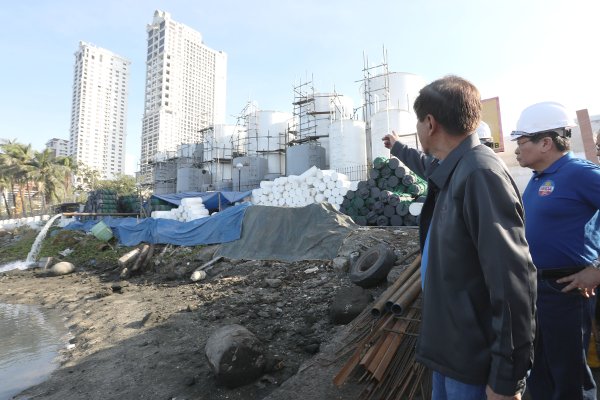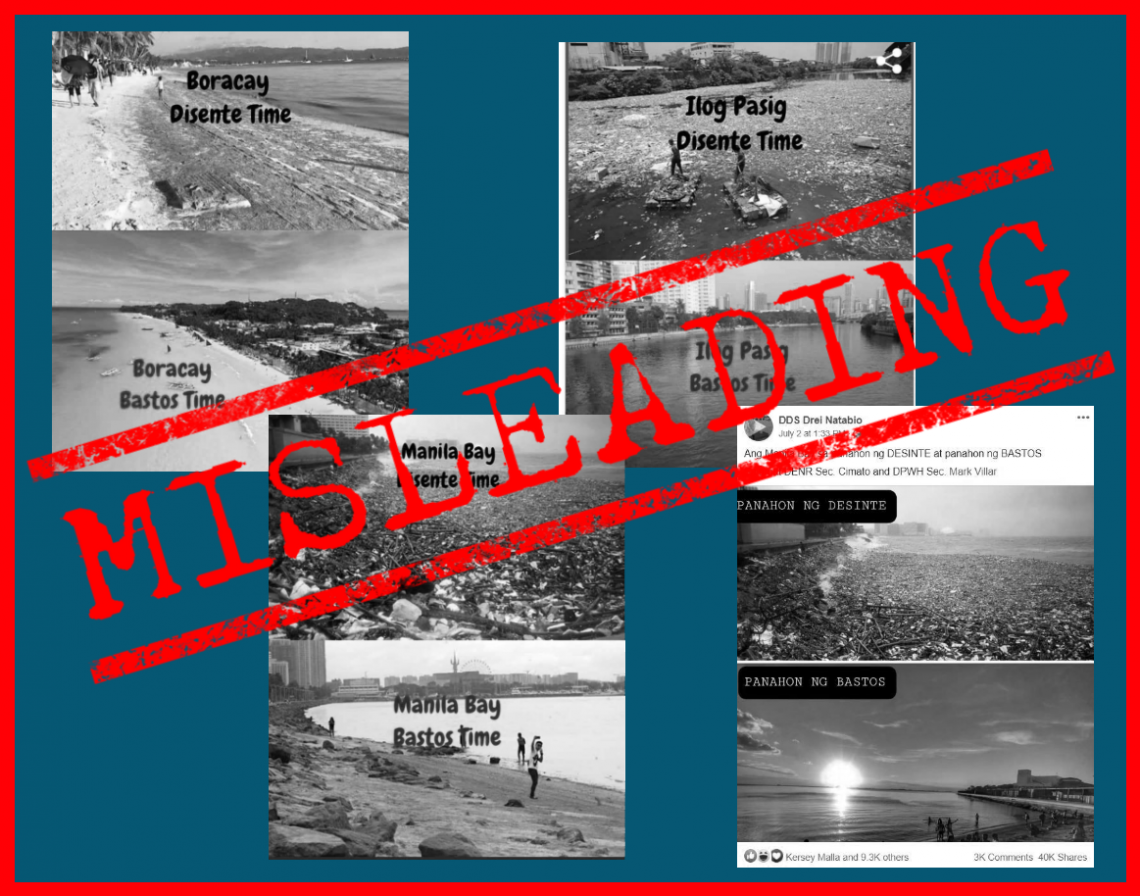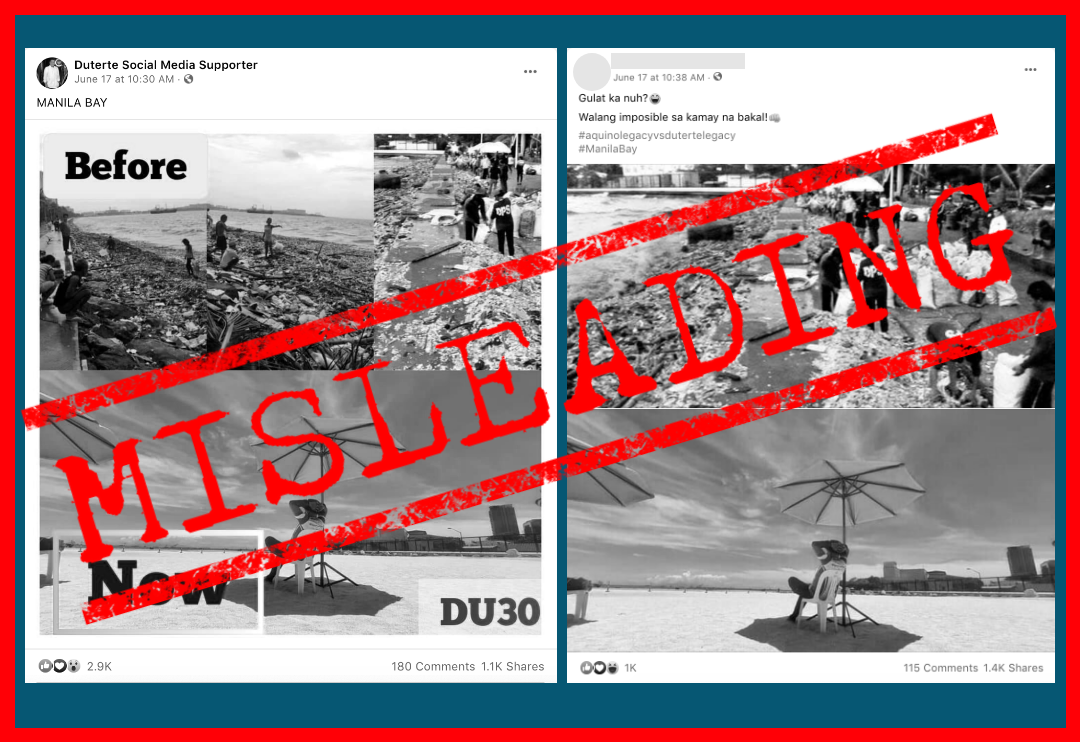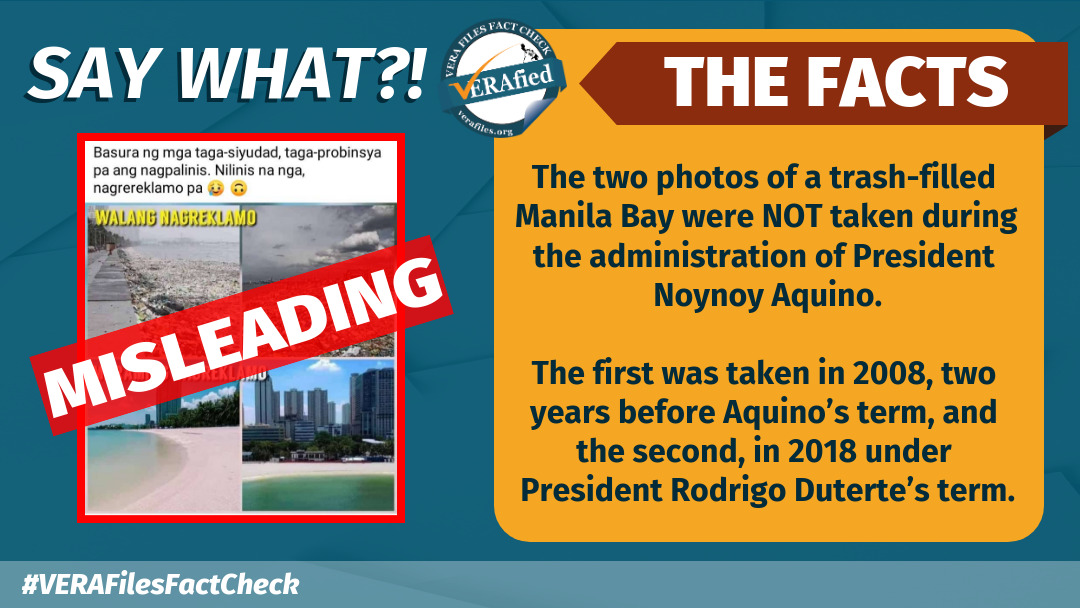Twenty-one years since a group of residents brought to court the deteriorating state of Manila Bay, much remains to be done to complete its rehabilitation.
The latest attempt involves the creation of an artificial white sand beach on a short stretch of the bay that costs P389 million out of the P47-billion budget for the comprehensive rehabilitation of Manila Bay. (See VERA FILES FACT CHECK: Post comparing Manila Bay rehab with old toilet project has MISLEADING budget figures)
Today, the public and some lawmakers turn their eyes on the agencies long mandated to restore the polluted bay.
In a Senate hearing on the proposed budget of the Department of Environment and Natural Resources (DENR) for 2021, Sen. Cynthia Villar asked Environment Secretary Roy Cimatu to “force” Maynilad Water Services, Inc. (MWSI) and the Manila Water Company, Inc. (MWCI) to shoulder the costs of siphoning overflowing septic vaults. She said:
“[T]ell the people that, since we’re paying for wastewater treatment, pag nao-over ‘yung kanilang mga septic vault, it’s the responsibility of Maynilad and Manila Water to get it because we’re paying for wastewater treatment in our water bill…Dapat ‘yon (sewage water), pagkuha ng Maynilad and Manila Water, dadalhin nila sa STP (sewage treatment plants) para paglabas sa river malinis na…kasi ‘di alam ng mga tao na they are entitled to that (siphoning services), hindi nila alam na ‘yung water bill nila may wastewater treatment.
([T]ell the people that, since we’re paying for wastewater treatment, when their septic vault spills over, it’s the responsibility of Maynilad and Manila Water to get it because we’re paying for wastewater treatment in our water bill…When Maynilad and Manila Water collect [the sewage water], they should bring it to the STP so that when the water flows into the river it is already clean…because the people don’t know that they are entitled to that; they don’t know that their water bill includes wastewater treatment.)”
Source: Senate of the Philippines official Youtube account, Senate Hearing on the Proposed 2021 Budget of the Department of Environment and Natural Resources and attached agencies, Oct. 9, 2020, watch from 1:01:19 to 1:02:20
Villar told Cimatu that the DENR should compel the water concessionaires to bear the costs of siphoning septic vaults to control the leak of wastewater and help the government’s efforts in rehabilitating bodies of water, like Pasig River and Manila Bay, among others.
In January, President Rodrigo Duterte blasted the water concessionaires for “contaminating” Manila Bay because they “failed” to build wastewater treatment lines.
But who exactly is responsible for managing the people’s septics and sewerage systems? Who keeps the waters clean?
Here are three things you should know about wastewater and how it affects Manila Bay’s rehabilitation:
1. Who is responsible for wastewater management?
Water concessionaires are responsible for the proper treatment and disposal of wastewater produced by their consumers.
Section 8 of Republic Act 9275, or the Philippine Clean Water Act of 2004, enumerates the responsibilities of water concessionaires, which include the collection, management, and disposal of sewage water in a timely manner.
The law, which took effect on May 6, 2004, mandates the protection, preservation, and revival of the country’s bodies of water and “recognizes” that issues in water management “cannot be separated” from those of public health and ecological protection.
It requires the government to devise and promote programs focusing on water pollution prevention.
Given five years from the effectivity of the law, the water firms supplying Metro Manila and other highly urbanized cities (HUCs) were required to connect the existing sewage line found in all subdivisions, condominiums, commercial centers, hotels, sports and recreational facilities, hospitals, market places, public buildings, industrial complex and other similar establishments, including households, to the available sewerage system.
On Oct. 7, 2009, then Environment Secretary Lito Atienza found regulator Metropolitan Waterworks and Sewerage System (MWSS) and concessionaires Maynilad and Manila Water to be in violation of this provision.
They were found to have failed to:
- provide, install, or maintain sufficient wastewater treatment facilities that are “satisfactory enough in quantity to meet the standards and objectives of the law,” and
- carry out the connection of the sewage line as stated in Section 8 of the Clean Water Act.
The DENR imposed a fine of P29.4 million, jointly and solidarily, covering May 7 to Sept. 30, 2009, when the three water entities failed to comply with the law.
Motions for reconsideration were filed separately at the Court of Appeals, which later dismissed the petitions and directed the firms to follow the DENR order.
On Aug. 6, 2019, the Supreme Court (SC) ruled that it is the water firms’ mandatory and unconditional obligation to comply with Sec. 8 of the Clean Water Act.
The decision also emphasized that the enactment of the Clean Water Act in 2004 means the water firms, the government, and the public are in a trust relationship. The relationship is anchored on a “universal tangible agreement” that water is a resource requiring protection primarily for the welfare of the people.
The SC fined Maynilad and Manila Water P921.464 million each. It also held the MWSS liable for the amount because of the concession agreements it entered with the two private water providers.
In 2008, the SC also resolved a mandamus case by ordering multiple government agencies to urgently act on the rehabilitation of the Manila Bay. Part of the order reads:
“The era of delays, procrastination, and ad hoc measures is over…Thus, we must reiterate that different government agencies and instrumentalities cannot shirk from their mandates; they must perform their basic functions in cleaning up and rehabilitating the Manila Bay.”
Source: Supreme Court, MMDA et al. vs. Concerned Residents of Manila Bay, Dec. 18, 2008
A “mandamus,” Latin for “we command,” is an order from a court compelling persons or government offices to do their duties according to what the law requires.
For this matter, the court handed down a continuing mandamus, or a continuing order, that requires all involved agencies to submit a quarterly progressive report of their rehabilitation plans to the court.
The court also directed the MWSS to provide, install, operate and maintain the necessary adequate wastewater treatment facilities in Metro Manila and other HUCs.
2. How are consumers charged for the sewage treatment?
Both Maynilad and Manila Water charge consumers for sewage treatment through the environmental fee. The private water providers compute this fee as 20 percent of the basic charge plus the foreign currency differential adjustment (FCDA) in their water bills.
The environmental fee, billed for both residential and industrial customers, covers the costs of desludging and watershed protection.
The Clean Water Act allows collection of sewerage service fees once a connection to the available sewerage system is established.
According to data obtained by VERA Files from MWSS, Maynilad and Manila Water have collected P32.81 billion combined in environmental fees from 1997 to 2018.
Exempted from paying the environmental fee are water consumers who use their own sewerage system, which should also meet the standards under the law.
With this, water consumers may avail themselves of the siphoning or desludging services of Maynilad and Manila Water without having to pay additional fees. The MWSS recommends that desludging services should be done every five to seven years to prevent the overflow of septic tanks.
Only industrial customers pay the sewerage charge, so long as they are connected to either Maynilad’s or Manila Water’s sewerage systems. This is computed as 20 percent of the basic charge for Maynilad and 30 percent for Manila Water.
As of 2019, Manila Water reported to have collected and treated 44.91 million cubic meters (MCM) of sewage and septic tank sludge.
3. How does this relate to Manila Bay rehabilitation?
Unmanaged wastewater, exacerbated by the absence of adequate wastewater management facilities, has been cited as a factor that adds to the degradation of Manila Bay’s water quality.
In its 2018 Situation Analysis Report, the National Economic and Development Authority’s (NEDA) Manila Bay Sustainable Development Master Plan (MBSDMP) reported data proving the continuous deterioration of water quality in Manila Bay.
The MBSDMP is NEDA’s master plan for the rehabilitation of Manila Bay, of which the white sand beach is not a part, DENR Undersecretary Jonas Leones said in a budget hearing at the House of Representatives.
The report estimated that the Manila Bay Region, composed of Metro Manila and Regions II, III, and IV-A, generates about 3.12 million cubic meters of wastewater a day.
The MBSDMP also noted that, with the current wastewater treatment facilities of Maynilad and Manila Water, only around 27 percent of the wastewater produced within the region is being treated.
A separate water quality improvement report indicated that the sewage produced by the increasing population in the Manila Bay Region remains unaccounted for by the existing sewerage systems.
Manila Bay’s continuous water quality degradation is also a consistent subject in the litigation of its rehabilitation since 1999.
During the trial of the Manila Bay mandamus case at a Regional Trial Court in Imus, Cavite, then Water Quality Management Chief Renato Cruz showed water samples from beaches around Manila Bay.
These samples were found containing 50,000 to 80,000 most probable number (MPN)/ml amount of fecal coliform. This is way above the water quality standard set for the Manila Bay, which should not exceed 200 mpn/100 ml.
In its 2019 decision, the SC summarily emphasized the magnitude of the water firms’ non-compliance with Section 8 of the Clean Water Act:
“The continued failure of providing a centralized sewerage system in compliance with the said law means that several sewage lines continue to dump and release untreated sewerage within their vicinities — resulting in unmitigated environmental pollution.”
It added:
“The fact of the matter is that, because of the failure to completely centralized [sic] the sewerage system and comply with Section 8 of the law, untreated water are [sic] continuously being dumped within existing water areas and the Manila Bay, resulting in the continued pollution of the said water areas.”
Chief Justice Diosdado Peralta restored the Manila Bay Advisory Committee on Jan. 23 as part of SC’s verification role in the continuing mandamus on Manila Bay’s rehabilitation.
Peralta recently said he was satisfied with the efforts of the DENR and other agencies involved in Manila Bay’s rehabilitation, following an ocular inspection of the artificial white sand beach with Cimatu and other SC justices.
He said he received reports that the current fecal coliform level of the bay is at 49 mpn/100ml.
Sources
Supreme Court of the Philippines, MMDA et al. vs. Concerned Residents of Manila Bay, Dec. 18, 2008
Department of Environment and Natural Resources Official Facebook Page, PRESS RELEASE: DENR assures integrity of beach nourishment project, Oct. 12, 2020
Philippine News Agency, Manila Bay makeover to benefit Filipinos’ mental health, Sept. 6, 2020
Philippine News Agency, Manila Bay white sand project will prevent soil erosion, floods, Sept. 7, 2020
Manila Bulletin, Group: P389-M budget for Manila Bay rehab could be used to plant 13,000 hectares of mangrove forests, Sept. 6, 2020
Inquirer.net, Environment groups slam DENR’s plan to fill Manila Bay shore with ‘white sand’, Sept. 3, 2020
CNN Philippines, Groups call white sand on Manila Bay ‘a sham,’ ‘purely aesthetic‘, Sept. 3, 2020
CNN Philippines, Senate probe sought on Manila Bay ‘white sand’ project, Oct. 3, 2020
ABS-CBN News, ‘Hilaw’: Some senators urge DENR to halt Manila Bay white sand project over health concerns, Sept. 7, 2020
Manila Bulletin, Senators want Manila Bay ‘white sand beach’ project suspended while ‘potential health hazards’ are unresolved, Sept. 7, 2020
Senate of the Philippines Official Youtube Account, Senate Hearing on the Proposed 2021 Budget of the Department of Environment and Natural Resources and attached agencies, Oct. 9, 2020
PCOO Official Facebook Account, Annual Celebration of the 120-Year Presence of the Baptist Churches in the Philippines, Jan. 16, 2020
Official Gazette of the Philippines, Republic Act No. 9275, March 22, 2004
Supreme Court of the Philippines, Maynilad Water Services, Inc. et al., Aug. 6, 2019
Lito Atienza’s Official WordPress Blog, The Biggest Violators of The Clean Water Act, April 23, 2009
GMA News Online, DENR fines 3 water firms P29.4M for violating Clean Water Act, Nov. 5, 2009
Supreme Court of the Philippines, MMDA et al. vs. Concerned Residents of Manila Bay, Dec. 18, 2008
Maynilad Water Official Website, How to Read Your Water Bill, Oct. 9, 2020
Manila Water Official Website, Bill Information, Oct. 9, 2020
Metropolitan Waterworks and Sewerage System, Total EC of MWCI & MWSI from 1997 to 2018, Oct. 21, 2020
Department of Public Works and Highways, National Building Code of the Philippines, Accessed Oct. 19, 2020
MWSS Official Website, Desludging Services Reminder to Customers, Aug. 16, 2019
Manila Water Official Website, Wastewater Issues in the Manila Concession, Accessed Oct. 13, 2020
Manila Bay Sustainable Development Master Plan, Manila Bay Sustainable Development Master Plan Situation Analysis Report, December 2018
Philstar.com, DENR: Manila Bay ‘beach nourishment’ not part of NEDA’s master plan, Sept. 9, 2020
Rappler, Artificial beach in Manila Bay not in NEDA’s master plan, DENR admits, Sept. 8, 2020
Manila Bay Sustainable Development Master Plan, Water Quality Improvements, December 2018
Philstar.com, Peralta satisfied with Manila Bay cleanup, Oct. 15, 2020
Inquirer.net, Supreme Court chief ‘satisfied’ with DENR work on Manila Bay, Oct. 15, 2020
Business Mirror, CJ Peralta pleased by bay cleanup, mum on dolomite, Oct. 15, 2020
GMA News Online, Cimatu, CJ Peralta join other execs in inspecting ‘dolomite beach’, Oct. 14, 2020
Department of Environment and Natural Resources, CIMATU UPDATES SC ON MANILA BAY REHAB EFFORTS, Oct. 14, 2020
Manila Bulletin, Cimatu discusses issues related to Manila Bay rehab to SC Chief Justice, 5 other justices, Oct. 14, 2020
(Guided by the code of principles of the International Fact-Checking Network at Poynter, VERA Files tracks the false claims, flip-flops, misleading statements of public officials and figures, and debunks them with factual evidence. Find out more about this initiative and our methodology.)




